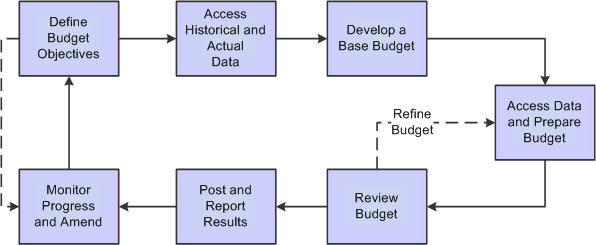Planning and Budgeting Process
Planning and Budgeting is an analytical application that helps you set top-down targets and generate a bottom-up budget, which is at the foundation of your organization's operations. It helps management evaluate business alternatives and set financial targets, and it enables the organization to work cooperatively and efficiently through the budgeting iterative process—reevaluating expenses and revenue estimates; changing start and end dates; and modifying objectives.
Planning and Budgeting enables different departments to use compatible tools based on the same assumptions. By delivering a shared business model with role-based access over the internet, every participant can interact with his or her portion of the business plan or budget at any time, from any global location. You can respond quickly and efficiently to the changing business environment. Through what-if analysis and modeling, you can simulate headcount changes, expense control strategies, and capital investment plans before implementation. Marketing volatility and other deviations from the original plan can be handled proactively, in real time, rather than once a year.
Use Planning and Budgeting to:
Develop planning targets.
Access and analyze historical and current data.
Connect strategic objectives with daily processes.
Link top-down targets with bottom-up budgets.
Integrate and update financial statements as business conditions change.
Conduct continuous forecasting.
Perform real-time, multidimensional modeling of your planning and budgeting data.
Like other PeopleSoft applications, Planning and Budgeting stores data in relational database tables. You can extract, view, analyze, and modify this data and then move it back into the original tables. Understanding the concepts behind this process—and the tools that help you manipulate the data—helps you perform your role in the planning and budgeting process at your organization.
Image: Planning and Budgeting process
This flowchart illustrates the Planning and Budgeting process, which includes defining budget objectives; accessing historical and actual data; developing a base budget; preparing, reviewing and refining a budget; posting and reporting results; and monitoring progress and amending the budget.
